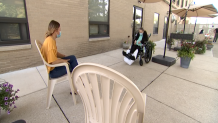There are no hugs allowed, but for Marie and Jacee Brija, just sitting across from each other is enough.
“It’s a little bit of heaven, that’s all I can tell you,” said Marie Brija, 84, a resident of Bridgeview Health Care Center. “I’ve waited so long.”
It’s been four months since families have been able to visit loved ones inside long-term care facilities. The coronavirus pandemic restricted visitors to curb the spread of the deadly virus that has wreaked havoc inside nursing homes across the country.
With the rate of deaths slowing, the Illinois Department of Public Health is allowing outdoor visits at facilities that meet certain criteria. Visitations are scheduled in advance and limited to two people per resident. Masks and social distancing are required, along with temperature checks and pre-screening.
Jacee Brija said finally laying eyes on her grandmother “means the world.”
“She’s my best friend,” Jacee Brija said. “We talk on the phone like three times a day.”
These outdoor visits are a signal of the progress made in the fight against coronavirus inside Illinois’ long-term care facilities.
Local
According to an NBC 5 Investigates analysis of state data, the number of deaths and cases have been holding steady after weeks of sharp increases. On July 10, IDPH reported 42 coronavirus-related deaths inside long-term care facilities over a one week period. At its peak on May 29, nearly 1,200 deaths were reported week-to-week.
Deaths inside long-term care facilities account for 55 percent of all coronavirus fatalities in Illinois, according to the state’s most recent data.
“While it might seem that we’ve moved beyond the peak of the crisis, that only happened because there are tireless nursing home workers that have dedicated themselves to this effort, and they continue to take all the steps necessary to protect our state’s most vulnerable residents,” said Pat Comstock, Executive Director of the Health Care Council of Illinois, which represents 300 licensed skilled nursing facilities in the state.
Comstock said facilities are “aggressively” testing residents and staff to keep the virus at bay.
“We’re committed to doing that on an ongoing basis,” Comstock said.
IDPH ordered nursing homes to develop individual test plans. Each facility is responsible for collecting specimens and contracting with laboratories to have them tested.
The state recently designated 25 facilities as COVID-19 homes. Residents who test positive are sent and isolated at the facilities to further curb the spread.
Despite the encouraging steps taken in the fight against the virus, the American Health Care Association and the National Center for Assisted Living sent a letter Tuesday to the National Governors Association, warning of imminent outbreaks at nursing homes. They cited spikes in new cases in several states, combined with shortages of personal protective equipment and significant delays in getting test results.
Researchers are also concerned how surging cases will impact deaths inside long-term care facilities.
“Nursing homes that are most likely to have outbreaks are those that are located in areas where there’s a lot of community spread,” said Dr. Tamara Konetzka, a professor of Health Services Research at University of Chicago.
Dr. Konetzka said the main reason deaths and cases have declined inside Illinois’ nursing homes is because of a sharp decline in statewide cases from mid-May to mid-June.
“What we have to remember though is that there's often a lag. And so, Illinois case numbers were coming down. That meant nursing homes were less at risk and we're going to see fewer nursing home cases and then fewer nursing home deaths.”
But there is concern as case numbers are trending upward in Illinois, though fortunately average daily deaths are not increasing.
“The main vehicle for spreading the virus or the virus getting into nursing homes is still staff, and staff come and go every day, and that’s why we see that nursing homes are at risk,” Dr. Konetzka said.
Nursing homes may have to restrict visits once again if outbreaks occur, said Dr. Konetzka.
“I am hoping we can continue the family visits because we know how to prevent transmission from those family visits, and we know that they are really important,” Dr. Konetzka said.

For the Brijas, the hardest part comes at the end of the 15 minute visit: the goodbye without a big hug.
“When are we going to be able to touch each other again?” Marie Brija said. “I promised not to cry.”
Jacee Brija promised to schedule another visit soon.
“The soonest opening they have, that’s the one I want," she said.



